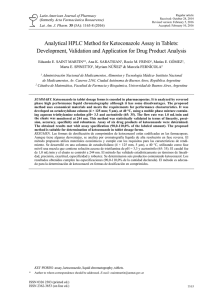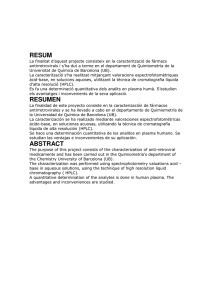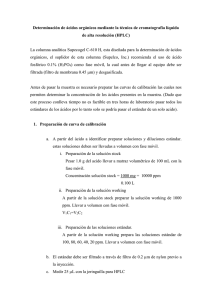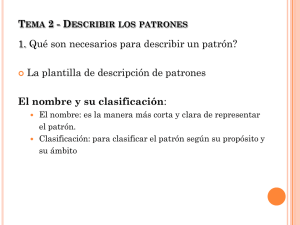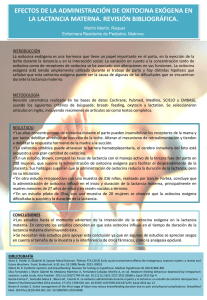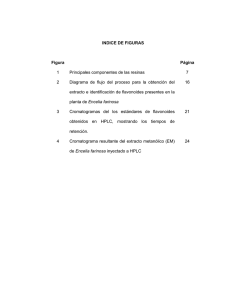Desarrollo y validación del método de cromatografía líquida de alto
Anuncio
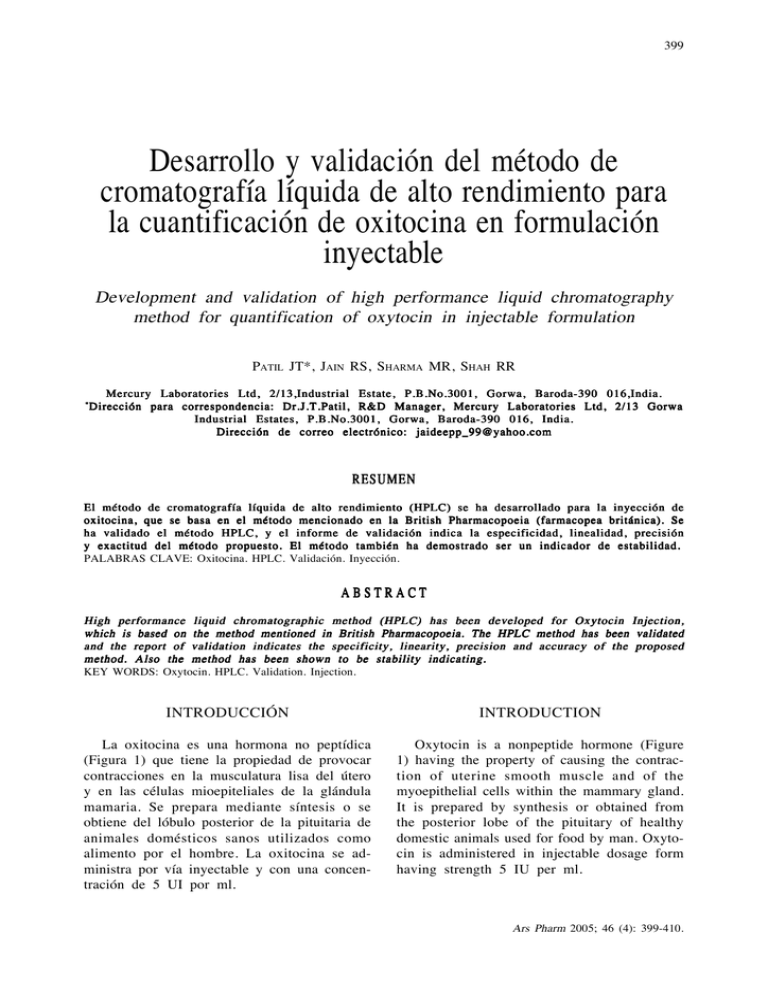
399 DESARROLLO Y VALIDACIÓN DEL MÉTODO DE CROMATOGRAFÍA LÍQUIDA DE ALTO RENDIMIENTO... DEVELOPMENT AND VALIDATION OF HIGH PERFORMANCE LIQUID CHROMATOGRAPHY METHOD ... Desarrollo y validación del método de cromatografía líquida de alto rendimiento para la cuantificación de oxitocina en formulación inyectable Development and validation of high performance liquid chromatography method for quantification of oxytocin in injectable formulation PATIL JT*, JAIN RS, SHARMA MR, SHAH RR * Mercury Laboratories Ltd, 2/13,Industrial Estate, P.B.No.3001, Gorwa, Baroda-390 016,India. Dirección para correspondencia: Dr.J.T.Patil, R&D Manager, Mercury Laboratories Ltd, 2/13 Gorwa Industrial Estates, P.B.No.3001, Gorwa, Baroda-390 016, India. Dirección de correo electrónico: jaideepp_99@yahoo.com RESUMEN El método de cromatografía líquida de alto rendimiento (HPLC) se ha desarrollado para la inyección de oxitocina, que se basa en el método mencionado en la British Pharmacopoeia (farmacopea británica). Se ha validado el método HPLC, y el informe de validación indica la especificidad, linealidad, precisión y exactitud del método propuesto. El método también ha demostrado ser un indicador de estabilidad. PALABRAS CLAVE: Oxitocina. HPLC. Validación. Inyección. ABSTRACT High performance liquid chromatographic method (HPLC) has been developed for Oxytocin Injection, which is based on the method mentioned in British Pharmacopoeia. The HPLC method has been validated and the report of validation indicates the specificity, linearity, precision and accuracy of the proposed method. Also the method has been shown to be stability indicating. KEY WORDS: Oxytocin. HPLC. Validation. Injection. INTRODUCCIÓN INTRODUCTION La oxitocina es una hormona no peptídica (Figura 1) que tiene la propiedad de provocar contracciones en la musculatura lisa del útero y en las células mioepiteliales de la glándula mamaria. Se prepara mediante síntesis o se obtiene del lóbulo posterior de la pituitaria de animales domésticos sanos utilizados como alimento por el hombre. La oxitocina se administra por vía inyectable y con una concentración de 5 UI por ml. Oxytocin is a nonpeptide hormone (Figure 1) having the property of causing the contraction of uterine smooth muscle and of the myoepithelial cells within the mammary gland. It is prepared by synthesis or obtained from the posterior lobe of the pituitary of healthy domestic animals used for food by man. Oxytocin is administered in injectable dosage form having strength 5 IU per ml. Ars Pharm 2005; 46 (4): 399-410. 400 PATIL JT, JAIN RS, SHARMA MR, SHAH RR. FIGURA 1. Estructura de la oxitocina. FIGURE 1. Structure of Oxytocin. Aparece en la farmacopea estadounidense (United States Pharmacopoeia, USP) 1, en la británica (British Pharmacopoeia, BP)2 y en la india (Indian Pharmacopoeia, IP)3. La cromatografía líquida de alto rendimiento (HPLC) también se ha utilizado para su análisis1,2,4-6, así como el método de bioensayo in vivo 3 . La intención de sustituir los bioensayos in vivo para el análisis de oxitocina y soluciones de oxitocina ha sido publicada en Pharmeuropa, la publicación del foro de la comisión de la farmacopea europea (European Pharmacopoeia Commission), para su comentario7. Los datos publicados por Maxl y Siehr en 1989 defienden que la variabilidad de las respuestas de los bioensayos in vivo es superior a la de los análisis fisicoquímicos, y que son menos fiables para la estandarización de la oxitocina 8. El presente trabajo consiste en el desarrollo y la validación del método HPLC basándose en el método de la farmacopea británica para la cuantificación de la oxitocina en formulación inyectable, con la intención de sustituir al método de bioensayo in vivo. It is listed in the United States Pharmacopoeia (USP)1, the British Pharmacopoeia (BP)2 and the Indian Pharmacopoeia (IP) 3. High performance liquid chromatography (HPLC) has been reported for its analysis1,2,46 and also in vivo bioassays method has been reported 3. The intention to replace in vivo bioassays for testing Oxytocin and Oxytocin solutions has been published in Pharmeuropa, the forum publication of the European Pharmacopoeia Commission, for comments7. The data published by Maxl & Siehr in 1989, which support that the in vivo bioassays were more variable in their responses than the physicochemical tests, and that they are less reliable for the standardization of oxytocin 8 . The present work deals with development and validation of HPLC method based on the method given in the British Pharmacopoeia for quantification of Oxytocin in injectable formulation with intention to replace the in vivo bioassays method. MATERIALS AND METHODS MATERIALES Y MÉTODOS Instrumental sistema HPLC Shimadzu equipado con bomba LC-10 AT vp con bucle de 100 µl y detector UV-Vis SPD-10Avp Reactivos y productos químicos Se utilizaron ácido ortofosfórico (calidad AR, S.D.Fine Chem Ltd, India) y acetonitrilo (grado HPLC, S.D.Fine Chem Ltd, India). Se utilizó agua para inyección durante el experimento y en nuestra inyección de oxitocina comercial interna utilizada para el estudio. Preparación de la fase móvil Se mezcló solución al 0,2% v/v de ácido ortofosfórico con acetonitrilo en una proporción de 83:17 v/v, se filtró a través de una membrana de 0,45 µ y se desgasificó. Ars Pharm 2005; 46 (4): 399-410. Instrument Shimadzu HPLC system equipped with pump LC-10 AT vp with 100 µl loop and UV-Vis Detector-SPD-10Avp Reagents and Chemicals Orthophosphoric acid (AR grade, S.D.Fine Chem Ltd, India), Acetonitrile (HPLC grade, S.D.Fine Chem Ltd, India) were used. Water for Injection was used throughout the experiment and our in-house commercial Oxytocin injection used for study. Preparation of Mobile Phase 0.2%v/v solution of Orthophosphoric acid and Acetonitrile were mixed in the ratio of 83:17v/v, filtered through 0.45 µ membrane filter and degassed. 401 DESARROLLO Y VALIDACIÓN DEL MÉTODO DE CROMATOGRAFÍA LÍQUIDA DE ALTO RENDIMIENTO... DEVELOPMENT AND VALIDATION OF HIGH PERFORMANCE LIQUID CHROMATOGRAPHY METHOD ... Condiciones cromatográficas Cromatógrafo: Sistema Shimadzu HPLC Columna: Phenomenex, Luna-C18 (25cm x 4.6 m), 5µ Detector: UV-220 nm Volumen de inyección: 100 µl Temperatura de la columna: 40 °C Velocidad de flujo: 1 ml/min RESULTADOS Y DISCUSIÓN Chromatographic Condition Chromatograph: Shimadzu HPLC System Column: Phenomenex, Luna-C18 (25cm x 4.6 m), 5µ Detector: UV-220 nm Injection Volume: 100 µl Column Temperature: 40°C Flow Rate: 1 ml/min RESULTS AND DISCUSSION CROMATOGRAFÍA CHROMATOGRAPHY La fase móvil resolvió la oxitocina con gran eficiencia, con un tiempo de retención inferior a 14 minutos. Los cromatogramas típicos de la preparación estándar y de la preparación de muestra se muestran en la Figura 2 y en la Figura 3 respectivamente. The mobile phase resolved the Oxytocin very efficiently with retention time lower than 14 minutes. Typical chromatograms of standard preparation and sample preparation are shown in Figure 2 and Figure 3 respectively. FIGURA 2. Cromatograma típico de la oxitocina estándar. FIGURE 2. Typical chromatogram of Standard Oxytocin. FIGURA 3. Cromatograma típico de la muestra de análisis de la inyección de oxitocina. FIGURE 3. Typical chromatogram of Test Sample of Oxytocin Injection. Ars Pharm 2005; 46 (4): 399-410. 402 PATIL JT, JAIN RS, SHARMA MR, SHAH RR. LINEALIDAD Y RANGO LINEARITY AND RANGE La linealidad de la respuesta se determinó preparando soluciones con un contenido de 1,2,4,8 y 16 UI/ml de oxitocina e inyectando cada una de ellas por duplicado en un sistema HPLC. Las áreas de pico medias obtenidas se indican en la Tabla 1. A partir de la pendiente de resultados se calcularon los coeficientes de interceptación y de correlación (r). Al aplicar el método propuesto, se siguió la linealidad en el rango de concentración de 1 UI – 16 UI/ml, y el coeficiente de correlación 0,9999 indica una buena linealidad entre la concentración y é área pico. El valor de la pendiente, 117483, indica la sensibilidad del método HPLC. The linearity of response was determined by preparing solution containing 1,2,4,8 & 16 IU/ml of Oxytocin and injecting each in duplicate on HPLC system. The mean peak areas obtained are given in Table 1. From the results slope, intercept and correlation coefficient (r) were calculated. By applying the proposed method, linearity was obeyed in the concentration range of 1 IU – 16 IU/ml and correlation coefficient 0.9999 indicates good linearity between concentration and peak area. The slope value 117483 indicates the sensitivity of HPLC method. TABLA 1. Resultados del estudio de linealidad. TABLE 1. Results of linearity study. Nivel Level Concentración UI/ ml Concentration IU/ ml Concentración nominal(%) Nominal Concentration(%) Área pico media Mean Peak Area 1 1 20% 115344,5 2 2 40% 229393,5 3 4 80% 469670,0 4 8 160% 934958,0 5 16 320% 1872495,5 Pendiente/Slope: 117483 Interceptación/Intercept: -2945,5 Coeficiente de correlación (r)/Correlation Coefficient (r): 0.9999 PRECISIÓN DEL SISTEMA SYSTEM PRECISION Se realizaron inyecciones repetidas de preparación estándar única en el sistema HPLC. Se determinaron las áreas y el tiempo de retención de la inyección de oxitocina, y los resultados se indican en la Tabla 2. Los valores de la desviación estándar relativa (DER) mencionados en la Tabla 2 son inferiores al 2%, lo que confirma la precisión del sistema analítico. Replicate injections of single standard preparation were made on to HPLC system. Areas and retention time of Oxytocin injection were determined and data is given in Table 2.The relative standard deviation (RSD) values mentioned in Table 2 are less than 2% confirming that the analytical system is precise. Ars Pharm 2005; 46 (4): 399-410. 403 DESARROLLO Y VALIDACIÓN DEL MÉTODO DE CROMATOGRAFÍA LÍQUIDA DE ALTO RENDIMIENTO... DEVELOPMENT AND VALIDATION OF HIGH PERFORMANCE LIQUID CHROMATOGRAPHY METHOD ... TABLA 2. Resultados del estudio de precisión del sistema. TABLE 2. Results of system precision study. Nº de inyección Injection no. Área pico Peak area Tiempo de retención (min) Retention time (min) 1 338422 12,843 2 336062 12,768 3 339354 12,693 4 339215 12,629 5 343038 12,565 Media Mean 339218,2 12,6996 DE SD 2510,2 0,10998 DER RSD 0,74% 0,866% PRECISIÓN (REPLICABILIDAD) PRECISION (REPEATABILITY) La precisión se evaluó mediante nueve determinaciones con tres niveles de concentración. Se prepararon muestras de 4,0 UI/ml, 5,0 UI/ml y 6,0 UI/ml por triplicado, y se analizaron mediante el método HPLC. Los resultados obtenidos se indican en la Tabla 3. Los valores de la desviación estándar relativa (DER) mencionados en la Tabla 3 son inferiores al 2%, lo que confirma la precisión del método analítico. Precision is assessed using nine determinations over a three concentration levels. Sample were prepared for 4.0IU/ml, 5.0IU/ml and 6.0IU/ml in triplicate and analyzed by HPLC method. The assay results obtained are given in Table 3.The relative standard deviation (RSD) values mentioned in Table 3 are less than 2 % confirming that the analytical method is precise. Ars Pharm 2005; 46 (4): 399-410. 404 PATIL JT, JAIN RS, SHARMA MR, SHAH RR. TABLA 3. Resultados del estudio de precisión. TABLE 3. Results of precision study. Ensayo nº Concentración (% del indicado en la etiqueta) Concentration (% Of label claim) Cantidad recuperada DERNMT 2,0 % Amount recovered Cantidad recuperada (%) (98,0%-102%) Amount Recovered (%)(98.0%-102%) 1 4,0 UI/ml(80,0%) 3,992 UI/ml 4,03 UI/ml 4,028 UI/ml 99,79 % 100,80% 100,70 % 0,55 % 2 5,0 UI/ml(100,0%) 4,99 UI/ml 4,99 UI/ml 4,996 UI/ml 99,88% 99,88 % 99,93% 0,08 % 3 6,0 UI/ml(120.0%) 6,08 UI/ml 6,067 UI/ml 6,05 UI/ml 101,36% 101,11% 100,94 % 0,20 % Media (% del ensayo) Mean (assay%) 100,94 % DE SD 0,64 DER RSD 0,63 % Assay No. RSDNMT 2.0 % EXACTITUD ACCURACY La exactitud se evaluó mediante nueve determinaciones con tres niveles de concentración. Se añadieron cantidades conocidas del analito al producto farmacológico analizado previamente para obtener concentraciones finales de 6,5 UI/ml, 8,0 UI/ml y 9,5 UI/ml, por triplicado, y se analizaron mediante el método HPLC. Los resultados del ensayo obtenidos se indican en la Tabla 4. Los valores porcentuales de recuperación obtenidos se encuentran dentro del límite estándar de entre 98 y 102%, lo que confirma la exactitud del método propuesto. Accuracy is assessed using nine determinations over a three concentration levels. Known quantities of the analyte were added to the pre-analyzed drug product to make final concentrations 6.5IU/ml, 8.0IU/ml and 9.5 IU/ml, in triplicate and analyzed by HPLC method. The assay results obtained are given in Table 4.The percentage recovery values obtained lie within the standard limit of 98 to 102%, which confirms that the proposed method is accurate. Ars Pharm 2005; 46 (4): 399-410. 405 DESARROLLO Y VALIDACIÓN DEL MÉTODO DE CROMATOGRAFÍA LÍQUIDA DE ALTO RENDIMIENTO... DEVELOPMENT AND VALIDATION OF HIGH PERFORMANCE LIQUID CHROMATOGRAPHY METHOD ... TABLA 4. Resultados del análisis de recuperación. TABLE 4. Results from recovery analysis. Ensayo nº Concentración Cantidad recuperada DERNMT 2,0 % Amount recovered Cantidad recuperada (%) (98,0%-102%) Amount Recovered (%)(98.0%-102%) Assay No. Concentration 1 6,5 UI/ml 6,60 UI/ml 6,59 UI/ml 6,51 UI/ml 101,62% 101,38% 100,15% 0,81% 2 8,0 UI/ml 8,14 UI/ml 7,98 UI/ml 7,92 UI/ml 101.75% 99,75% 99,02% 1,395% 3 9,5 UI/ml 9,42 UI/ml 9,56 UI/ml 9,38 UI/ml 99,16 % 100,64% 98,74% 1,59% Media (% del ensayo) Mean (assay%) 100,24% DE SD 1,161 DER RSD 1,158% RSDNMT 2.0 % RESISTENCIA (REPLICABILIDAD) RUGGEDNESS (REPRODUCIBILITY) El estudio de la replicabilidad del método analítico se realizó con una muestra con un contenido de 5 UI/ml de oxitocina, por un analista distinto, en días distintos y con tiempos de ensayo transcurridos distintos. Los resultados del ensayo se indican en la Tabla 5. El valor de DER del análisis realizado por un químico distinto, intradía e interdía, es inferior al 2%, lo que demuestra que el método desarrollado es reproducible. The reproducibility of analytical method was performed on sample containing a 5 IU/ml Oxytocin by different analyst, different days, different elapsed assay times. The assay results obtained are given in Table 5.The RSD value of analysis performed by different chemist, intraday and interday is less than 2%, which demonstrates that the method developed is rugged. Ars Pharm 2005; 46 (4): 399-410. 406 PATIL JT, JAIN RS, SHARMA MR, SHAH RR. TABLA 5. Resultados del estudio de robustez. TABLE 5. Results of ruggedness study. Parámetro Ensayo (%) Parameter Assay (%) Interdía Interday Intradía Intraday Analista Analyst Día 1 Day-1 100,65% 101,00% Día 2 Day-2 98,01% 98,26% Mañana Morning 99,65% 98,69% Tarde Evening 99,99% 100,28% Analista I Analyst-I 98,66% 99,2% Analista II Analyst-II 99,65% 98.69% ESTABILIDAD DE LA SOLUCIÓN ANALÍTICA Se guardaron soluciones de muestra de la prueba de exactitud durante 24 horas en un matraz con tapón a temperatura ambiente. Al cabo de 24 horas, se analizaron estas soluciones de muestra y se compararon con soluciones estándar recién preparadas. Se calcularon los cambios en el ensayo en relación a los valores iniciales, que se indican en la Tabla 6. El estudio de estabilidad de la solución analítica es estable hasta 24 horas después de su almacenamiento a temperatura ambiente. Ars Pharm 2005; 46 (4): 399-410. DER del ensay Valores(NMT 2,0%) RSD of Assay Values(NMT2.0%) 1,5% 0,69% 0,47 % STABILITY OF ANALYTICAL SOLUTION Sample solutions from accuracy test were kept for 24 hours in stopper flask at ambient temperature. At the end of 24 hrs, these samples solution were analyzed against standard solutions, which were freshly prepared. Changes in assay against initial values were calculated and given in Table 6.The stability study of analytical solution showed that the analytical solution is stable up to 24 hours on storage at ambient temperature. 407 DESARROLLO Y VALIDACIÓN DEL MÉTODO DE CROMATOGRAFÍA LÍQUIDA DE ALTO RENDIMIENTO... DEVELOPMENT AND VALIDATION OF HIGH PERFORMANCE LIQUID CHROMATOGRAPHY METHOD ... TABLA 6. Resultados de estabilidad de la solución analítica. TABLE 6. Results of analytical solution stability. Nº de ensayo Assay No. Concentración Concentration Ensayo (%) Assay (%) Inicial 0 h Initial0 hrs Después de 24 h After 24 hrs Límite Limit Cambio en24 h en relación a0 h Change24 hrs Vs. 0 hrs 1 6,5 UI/ml 101,0% 98,35% 98,0%-102,0% 2,65 % 2 8,0 UI/ml 100,04% 98,51% 98,0%-102,0% 1,99% 3 9,5 UI/ml 99,09% 99,88% 98,0%-102,0% 0,79% ROBUSTEZ ROBUSTNESS La robustez del método analítico se evaluó mediante un cambio en la velocidad de flujo y en la composición de la fase móvil. Los resultados obtenidos se indican en la Tabla 7. La robustez del método indicó que no existían cambios marcados en los parámetros cromatográficos, lo que demuestra la robustez del método desarrollado. The robustness of analytical method was performed by change in flow rate and change in mobile phase composition. The assay results obtained are given in Table 7. The robustness of the method showed that there were no marked changes in the chromatographic parameters, which demonstrates that the method developed is robust. TABLA 7. Resultados del estudio de robustez. TABLE 7. Results of robustness study. Parámetro Parameter Cambio en la velocidad de flujo Change in flow rate Ensayo (%) Assay (%) Tal cual As such -0,2 ml +0,2 ml Cambio en la composición de la fase móvil (acetonitrilo) Change in mobile phase composition (Acetonitrile) Tal cual As such + 10.0 % - 10.0 % DER de los valores del ensayo (NMT 2,0%) RSD of Assay Values (NMT2.0%) 98,66 % 99,2 % 98,96 % 99,04 % 98,80 % 98,60% 0,187% 98,66 % 99,2 % 99,0 % 98,94 % 98,06 % 98,2% 0,465 % Ars Pharm 2005; 46 (4): 399-410. 408 PATIL JT, JAIN RS, SHARMA MR, SHAH RR. ESTUDIO DE ESPECIFICIDAD (ENSAYO) SPECIFICITY (ASSAY) STUDY No interferencia de picos Non interference of peaks Para comprobar la especificidad del método, se inyectaron solución placebo y solución estándar de oxitocina (4 UI/ml), fase móvil. El tiempo de retención obtenido se indica en la Tabla 8. Los estudios de especificidad demostraron que ni el placebo ni la fase móvil presentan ningún pico en el tiempo de retención de la oxitocina. Esto confirma que los excipientes utilizados en la fabricación de la inyección no interfieren con el pico de oxitocina. To check the specificity of the method, mobile phase, solution of placebo and standard solution of Oxytocin (4IU/ml) was injected. The retention time obtained are given in Table 8. Specificity studies showed that the placebo as well as mobile phase does not show any peak at the retention time of the Oxytocin. This confirms that the excipients used in manufacturing of injection do not interfere with Oxytocin peak. TABLA 8. Resultados del estudio de especificidad. TABLE 8. Results of specificity study. Soluciones Solutions Tiempo de retención (min) Retention time (min) Tiempo de retención relativo TRR Relative retention time RRT Fase móvil Mobile phase 3,701 min 0,30 min Placebo Placebo 52,160 min 4,36 min Oxitocina Oxytocin 11,957 min 1,0 min Estudio de estabilidad Stability Study Para comprobar si el método desarrollado es indicativo de la estabilidad, la solución estándar de oxitocina se sometió a condiciones de estrés, tales como el tratamiento con 0,1 N de ácido clorhídrico, 0,1 N de hidróxido sódico y 1,0 % de peróxido de hidrógeno, para iniciar la degradación. La solución de oxitocina se sometió a degradación forzada manteniendo una solución con una concentración cinco veces superior a la indicada en la etiqueta a temperatura ambiente durante 1 hora, 24 horas y 36 horas, y se analizó con las condiciones cromatográficas indicadas anteriormente, pero utilizando un detector fotográfico de matriz de diodos. Los resultados se resumen en la Tabla 9. Los resultados del estudio de estabilidad en condiciones de estrés demuestran que el fármaco se resuelve correctamente, lo que confirma que el método desarrollado para el ensayo de la inyección de oxitocina es indicador de la estabilidad. To check the developed method is stability indicating, the standard solution of Oxytocin was subjected to stressed conditions like treatment with 0.1 N Hydrochloric acid, 0.1 N Sodium Hydroxide and 1.0 % Hydrogen peroxide to initiate degradation. Solution of Oxytocin were subjected to forced degradation by keeping solution having concentration five times higher of the label claim at ambient temperature for 1hr, 24 hr, 36 hr and analyzed by the above developed chromatographic conditions but using Photo Diode Array Detector. The results are summarized in Table 9. The results of stability study under stressed conditions showed that the drug is well resolved which confirmed that the method developed for assay of Oxytocin injection is stability indicating. Ars Pharm 2005; 46 (4): 399-410. 409 DESARROLLO Y VALIDACIÓN DEL MÉTODO DE CROMATOGRAFÍA LÍQUIDA DE ALTO RENDIMIENTO... DEVELOPMENT AND VALIDATION OF HIGH PERFORMANCE LIQUID CHROMATOGRAPHY METHOD ... TABLA 9. Resultados del estudio de estabilidad. TABLE 9. Results of stability study. Condición expuesta (TRR) Condition Exposed (RRT) Estándar (tal cual) Std(As it is) % de impurezas en el TRR % Impurity at RRT 0,1 N HCl 0,1 N NaOH 1,0% H 2O 2 Inicial Después Inicial Después Inicial Después Initial de 36 horas Initial de36 horas Initial de36 horas After After After 36 hour 36 hour 36 hour 1,0 min (oxitocina) (Oxytocin) 98,38% —- —- —- —- —- —- 1,17 min —- —- —- —- 8,10% —- —- 1,25 min —- —- —- —- 20,31% —- —- 1,45 min —- —- 1,12 % —- 1,53% —- —- 1,70 min —- —- —- —- —- —- 3,612 % Ensayo (%) Assay % —- 102,68% 64,5% 96,02% 40,21% 95,69% 16,89% Pureza máxima Peak purity —- P P P P P P P: pico presente P: Peak present CONCLUSIONES CONCLUSIONS El método validado de cromatografía líquida de alto rendimiento propuesto para la determinación de la oxitocina en formulaciones inyectables es exacto, preciso, sensible, selectivo y reproducible. Por tanto, se puede adoptar fácil y cómodamente como método de control de calidad rutinario en lugar del bioensayo in vivo mencionado en la farmacopea india. The validated High performance liquid chromatographic method proposed for the determination of Oxytocin in injectable formulation is accurate, precise, sensitive, selective and reproducible. It can, therefore, be easily and conveniently adopted for routine quality control method over in vivo bioassay mentioned in The Indian Pharmacopoeia. BIBLIOGRAFÍA/BIBLIOGRAPHY 1. United States Pharmacopoeia 28/ National Formulary 23, United States Pharmacopoeial Convention, Inc, Rockville, 2004; 1454-1455. 2. British Pharmacopoeia, Department of Health and Social Security, Welsh office, Ministry of Health and Social Services of Northern Ireland, 2003; 2540- 2541. 3. The Indian Pharmacopoeia, fourth ed., Controller of Publications, New Delhi, 1996; 1: 551. 4. Dudkiewicz-Wilczynska J, Snycerski A, Tautt J., HPLC method for the determination of oxytocin in pharmaceutical dosage form and comparison with biological method. Acta Pol Pharm. 2000 Nov-Dec; 57(6): 403-6. ., Quantitative analysis of nonapeptides in pharmaceutical dosage forms by high-performance liquid 5. Krummen K, Frei RW., chromatography, J Chromatogr. 1977 Feb 21; 132(3): 429-36 Ars Pharm 2005; 46 (4): 399-410. 410 PATIL JT, JAIN RS, SHARMA MR, SHAH RR. 6. Maxl F, Siehr W., The use of high-performance liquid chromatography in the quality control of oxytocin, vasopressin and synthetic analogues, J Pharm Biomed Anal. 1989; 7(2): 211-6 7. Anon. (1994). Note on the revision of the monographs Oxytocinum and Oxytocini solutions. Pharmeuropa 6: 377-386. 8. Maxl, F. & Siehr, W. (1989). The use of high-performance liquid chromatography in the quality control of oxytocin, vasopressin, and synthetic analogues. Journal of Pharmaceutical and Biomedical Analysis 7: 211-216. Ars Pharm 2005; 46 (4): 399-410.
